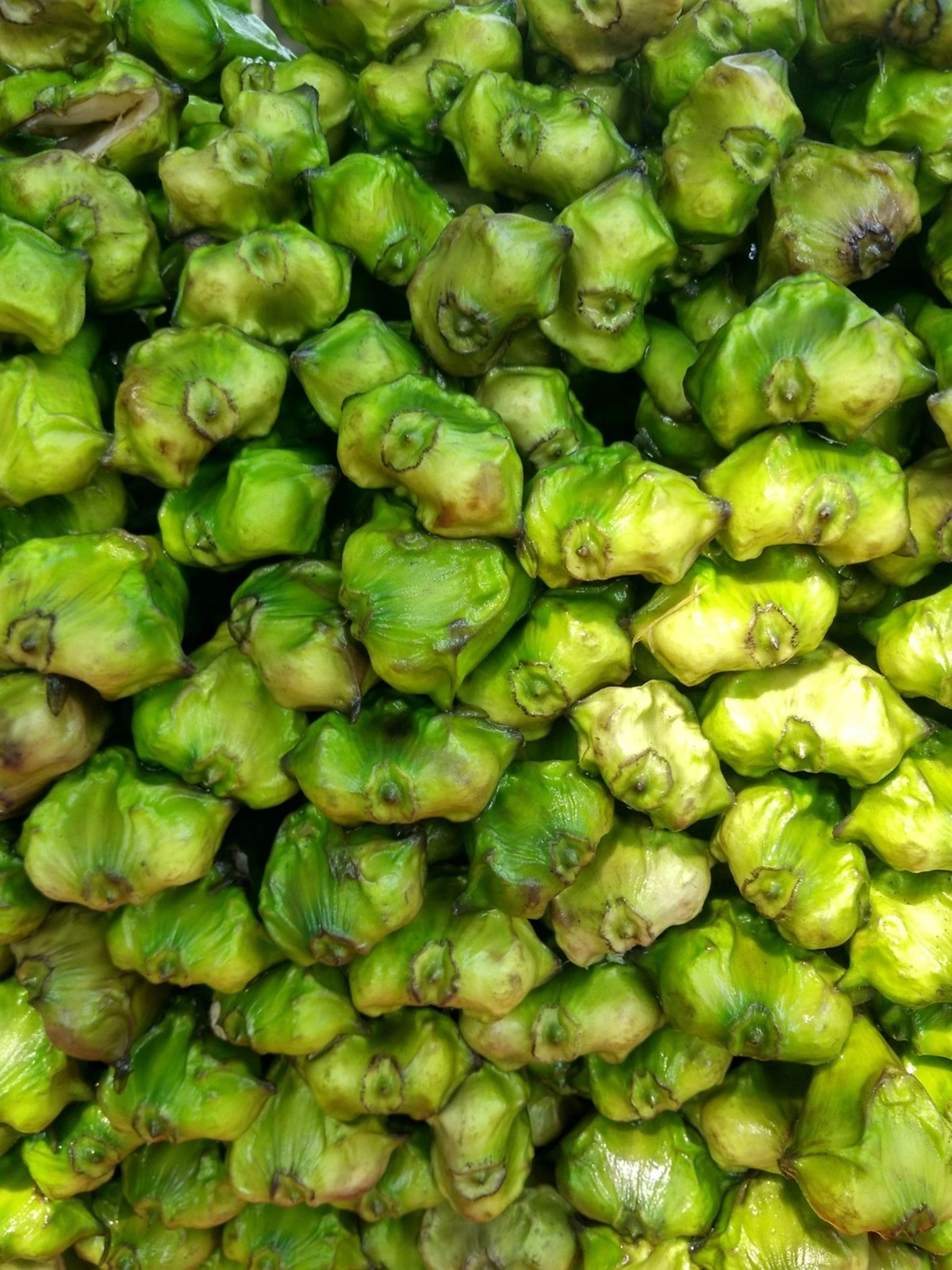Singhara, also known as water chestnut or Chinese chestnut, has the botanical name Trapa natans. It is an annual aquatic vegetable grown in marshes, lakes, ponds, or under water. This healthy, hydrating, and nutritious winter snack offers a wealth of health benefits for people of all ages.
NUTRITION PROFILE OF SINGHARA
Before exploring its health effects, let’s look at what makes singhara so powerful. This nutrient-dense food is rich in complex carbohydrates, unsaturated fats, dietary fiber, and protein. It contains essential minerals such as calcium, sodium, phosphate, magnesium, copper, manganese, potassium, iron, and zinc, along with vitamins like vitamin C, vitamin B6, folate, thiamine, riboflavin, and niacin. Powerful antioxidants including gallic acid, ellagic acid, and ferulic acid further enhance its health value and protective effects.
HEALTH BENEFITS OF SINGHARA
With such an impressive nutrient profile, it’s no surprise that singhara supports many aspects of health. It can be enjoyed in versatile ways raw, boiled, sliced, pickled, as chips, or in bakery products such as gluten free bread, pancakes, and desserts made with chestnut flour. It also blends well in fruit juices and smoothies thanks to its energizing and naturally cooling nature. Let’s move through its most noteworthy benefits one by one.
CAN SINGHARA HELP LOWER BLOOD PRESSURE?
One of the standout benefits of singhara is its potential to support heart health. Studies suggest that a high potassium diet helps lower blood pressure and reduce the risk of cardiovascular diseases, especially stroke.
One hundred grams of raw sliced water chestnut contains approximately 584 mg of potassium. Potassium acts as a natural diuretic, promoting the excretion of excess sodium and fluid. This reduces venous return to the heart, lowers cardiac output, and ultimately decreases blood pressure. It also relaxes blood vessels (vasodilation) and maintains fluid balance, which reduces pressure on the vessel walls. Including potassium-rich foods like singhara may therefore help manage hypertension and support overall cardiovascular health.
SINGHARA AND THYROID HEALTH
Moving from heart to hormonal health, singhara also contains iodine a mineral crucial for thyroid hormone production making it supportive of healthy thyroid function and metabolism.
A NATURALLY GLUTEN FREE FOOD
For those with celiac disease or gluten intolerance, singhara flour provides a safe and nutritious alternative. Its naturally gluten free quality makes it an excellent choice for baking or as a thickening agent in recipes.
SINGHARA AS A NATURAL COOLANT
As we shift to its seasonal benefits, singhara’s high water content gives it excellent cooling properties. During hot or dry weather, it helps regulate body temperature, promotes salivation, and quenches thirst. Its potassium content balances body electrolytes, while its alkaline nature aids digestion and helps reduce internal heat and acidity.
RELIEF IN JAUNDICE
Singhara also supports liver health. Its combination of potassium, antioxidants, vitamins, and high-water content helps flush out toxins, cleanse the liver, and purify the blood, providing relief during jaundice.
SUPPORT DURING MEASLES
Because of its immune boosting nutrients and cooling effects, singhara can be a soothing dietary addition for those recovering from measles, helping ease fever and skin irritation.
SINGHARA AND GOUT
For joint health, singhara’s anti-inflammatory and alkaline properties reduce uric acid buildup, making it a helpful dietary choice for managing gout.
SINGHARA FOR ULCERS
Digestive health benefits extend further. High fiber, cooling effects, and anti-inflammatory activity may help soothe and support healing in ulcers. Although limited studies support these benefits, future research will clarify its full potential.
URINARY TRACT INFECTIONS
When it comes to urinary health, singhara’s mild diuretic action, high water content, and antioxidant profile help flush out toxins, reduce bladder inflammation, and support a healthy urinary tract.
MOOD AND SLEEP QUALITY
The benefits of singhara are not limited to the body it also nurtures the mind. Its antioxidants reduce oxidative stress, which can improve mood and reduce anxiety. Vitamin B6 regulates mood swings, supports melatonin production (the sleep hormone), and promotes relaxation for better sleep quality.
GLOWING SKIN
Healthy skin reflects inner well-being. Singhara’s detoxifying and anti-inflammatory properties, combined with vitamin C (for collagen production), potassium and zinc (for wound healing), and ample hydration, help maintain skin elasticity and prevent premature aging.
DIGESTIVE HEALTH
A strong digestive system is essential for overall wellness. Fiber in singhara regulates bowel movements and supports gut health. Its antibacterial, antiviral, and astringent qualities help manage diarrhea, loose stools, and dysentery, while potassium balances electrolytes lost during illness.
ANTI-DIABETIC POTENTIAL OF SINGHARA
One of singhara’s most exciting roles is in blood sugar management. Its low glycemic index and high fiber content make it a smart dietary addition for people with diabetes or those at risk.
• Low Glycemic Index
Because singhara is a low-glycemic, low-calorie food with high fiber and water content, it prevents sudden spikes in blood sugar, offering steady energy and better glycemic control.
• Fiber for Blood Sugar Regulation
Both soluble and insoluble fibers in singhara work in harmony:
1. Soluble fiber forms a gel-like substance that slows digestion and carbohydrate absorption, preventing rapid rises in blood sugar and cholesterol.
2. Insoluble fiber improves insulin sensitivity and reduces insulin resistance, helping the body use insulin more effectively.
Its high fiber content promotes satiety, supports appetite control, and aids in weight management, all of which contribute to better blood sugar regulation.
• Reducing Diabetes Risk Factors
Beyond sugar control, singhara helps manage weight with its low fat and calorie content, reduces inflammation and oxidative stress through antioxidants like tannins, flavonoids (quercetin, rutin), and polyphenols (gallic, ellagic, and ferulic acids), and strengthens immunity with vitamin C and B6.
JOINT AND BONE HEALTH
Strong bones and joints require a steady supply of minerals, and singhara delivers. Packed with calcium, magnesium, and vitamin C, it supports bone density and helps prevent deficiencies. In traditional medicine, singhara flour is often used to improve bone health and replace calcium supplements.
RESPIRATORY HEALTH
During dry, cold weather, singhara’s cooling and soothing properties may provide relief from dry cough, bronchitis, and sore throat. Its immune-boosting nutrients further support respiratory wellness and help the body fight seasonal infections.
SINGHARA AND MALE FERTILITY
Men’s health can also benefit from singhara. Its zinc, calcium, and essential vitamins may improve sperm count, motility, and overall fertility. It can also boost energy and stamina, supporting reproductive health naturally.
ANTI-TUMOR POTENTIAL
Emerging laboratory research suggests that singhara’s antioxidants may have anti-cancer properties. While early results are promising, more human studies are needed to confirm these effects.
FEMALE HEALTH
Women’s health receives equal support from this versatile food. Singhara helps balance hormones, regulate menstrual cycles, and ease cramps and mood swings. Folate supports fetal development and helps prevent neural tube defects during pregnancy. Its nutrients and anti-inflammatory properties may also assist with postpartum recovery and help reduce pregnancy-related hypertension (preeclampsia). However, pregnant women should always consult a healthcare provider before using singhara therapeutically.
TAKEAWAY
From heart health and blood sugar control to skin radiance and reproductive wellness, singhara is a budget-friendly superfood that delivers a surprising range of health benefits. While it offers valuable dietary support, it should not replace medical treatment. For any medical condition, always seek advice from a qualified healthcare provider. Moderation is key to enjoying its full potential.
FREQUENTLY ASKED QUESTIONS (FAQs)
1. Can I eat singhara every day?
Yes, singhara can be eaten daily in moderate amounts. Its high fiber and mineral content make it a healthy snack, but portion control is important to avoid excessive calorie intake.
2. Is singhara good for people with diabetes?
Absolutely. Singhara has a low glycemic index and high fiber content, which help prevent sudden spikes in blood sugar levels and improve insulin sensitivity.
3. Can pregnant women consume singhara?
Yes, singhara is rich in folate and other nutrients that support fetal development and reduce the risk of neural tube defects. However, pregnant women should consult their healthcare provider before adding large amounts to their diet.
4. Does singhara really cool the body?
Yes. Its high-water content and potassium rich profile help regulate body temperature, making it an excellent natural coolant during hot or dry weather.
5. Is singhara gluten-free?
Yes, singhara and singhara flour are naturally gluten free and suitable for people with gluten intolerance or celiac disease.
DISCLAIMER:
This article is for informational and educational purposes only and is not a substitute for professional medical advice, diagnosis, or treatment. Always consult a qualified healthcare provider before making significant dietary changes or using singhara for any specific health condition.
CALL-TO-ACTION
Add singhara to your winter grocery list and enjoy its crunchy goodness in smoothies, soups, or baked treats. Whether you’re looking to improve heart health, manage blood sugar, or simply enjoy a hydrating snack, this seasonal superfood is a simple way to nourish your body from within. Try it today and experience the benefits nature has packed in this aquatic nut!
REFERENCES
1. National Center for Biotechnology Information (NCBI). Nutritional composition and health benefits of water chestnut (Trapa natans). Available from: PubMed database.
2. USDA FoodData Central. Water chestnut, raw nutrient profile and analysis.
3. Journal of Food Science and Technology. Antioxidant activity and mineral content of Trapa natans flour. 4. International Journal of Food Properties. Effects of water chestnut polyphenols on glucose metabolism and lipid profile.




